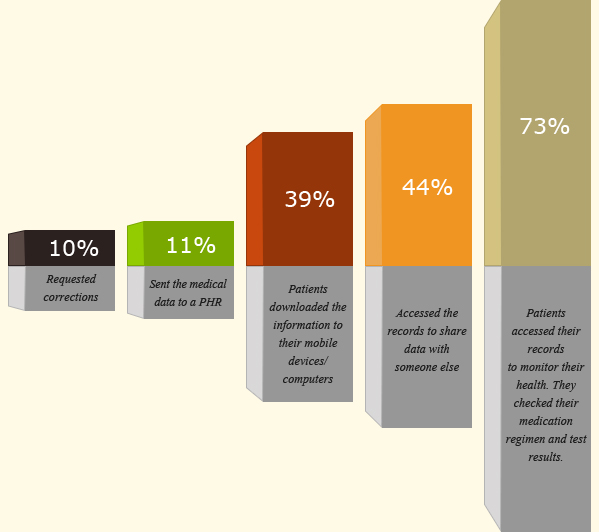Many physicians have inhibitions about allowing patients to access their own medical records online. The common fears include possible misuse of data, harm to patients/practice and increased workloads. However, these fears are largely unfounded because when patients are allowed to view their records online, it is more likely to improve patient experience, while also improving safety, effectiveness of treatment and shared decision making. It is seen that this approach can improve the patient’s relationship with his/her physician and enable them to feel more in control of their health. It is important that the online system is user friendly and works well for patients and practices.
A survey of more than 2100 people conducted by the ONC last year shows that 30% of patients have been offered access to their online records by their payer/healthcare provider. This is only a small group of patients. The results throw light on the limited capabilities of providers as regards viewing, downloading and transmitting healthcare data. In the year 2013, less than half of all office-based physicians had the computerized capability to ensure that their patients were able to view, download and transmit (VDT) electronic healthcare data. Moreover, only about a quarter of the physicians used this capability on a regular basis. Other results of the survey include:
- 48% of the consumers who had access to their medical records were offered the access by a healthcare provider.
- 44% were offered access by both a healthcare provider and insurer, and 7% were offered access by an insurer alone.
- Among those offered access, 46% viewed their records at least once last year. Within that group 21% viewed their records one or two times, 15% viewed their records three to five times, 4% viewed their records six to nine times and 6% viewed them more than 10 times.
Why Patients Accessed Their Records
- Around 73% of the patients accessed their records to monitor their health. They checked their medication regimen and test results.
- 44% accessed the records to share data with someone else.
- 39% of patients downloaded the information to their mobile devices/computers.
- 11% sent the medical data to a PHR or an app.
- 10% requested corrections in their medical data.
Sixty percent of patients found the new approach very useful while 3% did not find it useful. The patients who were offered access but didn’t make use of the opportunity either didn’t need to use the records (74%), or were concerned about privacy risks (28%), or didn’t have internet access (23%), or found it difficult to use websites (16%). The survey was an eye opener in that the results suggest that even in the early stages of online medical record availability, patients valued the new approach and found it useful. Importantly, 70% of the people surveyed were of the opinion that online access to their medical records was very or somewhat important. Even those who were offered access but did not view their medical records said that online access was very or somewhat important.
When people are allowed access to their records, they tend to care better for themselves. For example, people who habitually smoke or drink stop the habit or comply with their medication. More significantly, the relationship between providers and patients improve when there is transparency and patients start trusting their physicians more. Patients can make updates and fix errors if any in their history. This will save the physician considerable time and effort, and will also help avoid complications connected with any wrong/misleading information in the records. Providers can direct consumers on how to use the online system properly and avoid any complications possible. Reliable systems are designed to cope with data protection issues. Practices that do offer record access report there are only few problems associated with this system.




